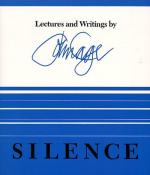
|
| Name: _________________________ | Period: ___________________ |
This test consists of 5 short answer questions, 10 short essay questions, and 1 (of 3) essay topics.
Short Answer Questions
1. According to Cage's essay on him, Erik Satie said who was not clumsy in his publicity?
2. Who wrote "Quantitaten"?
3. When was "The Future of Music: Credo" first presented?
4. Who accompanied Cage and eight children on a trip to a zoo?
5. When was "Experimental Music" first presented?
Short Essay Questions
1. What does Cage say about finding facts on the life and work of Edgard Varese?
2. How has Cage's process of composition evolved?
3. Describe the story Cage retells of when his mother asked his father to go to church.
4. How does Cage think most people feel about experimentation?
5. How does Cage answer his own question about whether music can be composed without writing it in pencil or ink?
6. How did painter Willem de Kooning respond when asked what painters of the past had influenced him?
7. Why does the author say he is grateful to Richard K. Winslow?
8. How does Cage feel about poetry, according to what he says in his Foreword?
9. Describe the anecdote used at the conclusion of "Composition as Process--2: Indeterminacy" about Dr. Suzuki.
10. What does Cage say about Erik Satie's relevance?
Essay Topics
Write an essay for ONE of the following topics:
Essay Topic 1
What reasons does Cage give for saying America has an intellectual climate suitable for radical experimentation? What does he mean when he says the country knows "nowness"? How does America being a newer country help make it a suitable place for radical experimentation? What ideas does the country tend to reject throughout its history?
Essay Topic 2
Explore the author's feelings on the nature of sound. What does Cage say about sound in "Experimental Music: Doctrine"? What does he say about the nature of sound? What does he say about interpreting it?
Essay Topic 3
Explore the author's dedication to innovation and change as seen through his layout on the page. What are some of the techniques Cage uses when writing? What different visual styles does he use? Why do you think he does this? What is he trying to say with his non-traditional style of writing?
|
This section contains 655 words (approx. 3 pages at 300 words per page) |

|




